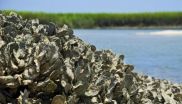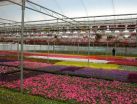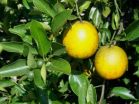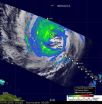(Press-News.org) SPRINGFIELD, MO—The American elderberry is showing promise as a profitable commercial fruit crop. Traditionally used for making jelly, juice, and wine, elderberry is becoming increasing important in North America's burgeoning "nutraceutical" industry. Historically, elderberries have mostly been harvested from the wild; researchers have made recently made efforts to select or develop improved cultivars. Increased interest and emerging markets are encouraging scientists to develop improved elderberry cultivars that yield consistent, superior production. Scientists from the University of Missouri have introduced a new variety named 'Wyldewood', a tall, vigorous elderberry plant that consistently produces heavy yields, is efficient to harvest, and produces fruit well-suited for processing.
The Elderberry Improvement Project was initiated at Missouri State University and the University of Missouri in 1997 with the goal of developing American elderberry cultivars adapted to Midwestern environments. 'Wyldewood' is the first cultivar released from the program. Originally described and tested as 'Brush Hills 1' and 'Wyldewood 1', the new release was identified and collected from the wild by Jack Millican in 1995 near the community of Brush Hill, Oklahoma. The cultivar was named in honor of Wyldewood Cellars Winery of Mulvane, Kansas, a leading promoter of elderberry production in the Midwest and a supporter of the Elderberry Improvement Project. 'Wyldewood' was tested and observed beginning in 1998 at two locations in southern Missouri.
According to corresponding author Patrick L. Byers of the University of Missouri Cooperative Extension Service in Springfield, 'Wyldewood' outperformed the standard 'Adams II' elderberry in yield potential and berry size; 'Wyldewood berry weights ranged from a low of 52 mg to a high of 111 mg. The harvest season for 'Wyldewood' is generally 14 to 26 days later than the standard 'Adams II', with harvest usually beginning in late July in Missouri.
A limited number of unrooted cuttings of 'Wyldewood' are available for test purposes to federal and state experiment stations from University of Missouri and Missouri State University by contacting the authors.
###
The complete study and abstract are available on the ASHS HortScience electronic journal web site: http://hortsci.ashspublications.org/cgi/content/full/45/2/312
Founded in 1903, the American Society for Horticultural Science (ASHS) is the largest organization dedicated to advancing all facets of horticultural research, education, and application. More information at ashs.org
'Wyldewood,' first release from Elderberry Improvement Project
Long-term research produces results for Missouri fruit breeding program
2010-09-21
ELSE PRESS RELEASES FROM THIS DATE:
'Blue Suede' premiers: New blueberry recommended for home gardeners
2010-09-21
GRIFFIN, GA—Blueberry aficionados will soon have a tasty, colorful new variety for their backyard gardens. Blueberry experts D. Scott NeSmith and Mark K. Ehlenfeldt introduced 'Blue Suede™' in a recent issue of HortScience. The new southern highbush blueberry (Vaccinium hybrid) was released by the University of Georgia's College of Agricultural and Environmental Sciences, the University of Georgia Agricultural Experiment Station, and the U.S. Department of Agriculture–Agricultural Research Service. 'Blue Suede™' is targeted for sales to the home gardener market.
According ...
Purdue researcher cracks open secret of oysters' ability to stick together
2010-09-21
WEST LAFAYETTE, Ind. - A Purdue University-led research team has uncovered the chemical components of the adhesive produced by oysters, providing information that could be useful for fisheries, boating and medicine.
A better understanding of oysters' ability to stick together to form complex reefs would help those trying to boost the dwindling oyster population, aid in the creation of materials to keep boat hulls clean without harming the environment, and bring researchers one step closer to creating wet-setting adhesives for use in medicine and construction.
Jonathan ...
Rotating high-pressure sodium lamps provide flowering plants for spring markets
2010-09-21
EAST LANSING, MI—When consumers visit garden centers in spring they will most likely buy flowering ornamental plants that are ready for their home gardens. Studies have shown that consumers favor plants that are already in flower rather than those that are "vegetative"—a preference that can present multiple challenges for commercial growers.
To satisfy consumers' wishes, producers of ready-to-flower ornamentals like bedding plants and perennials start growing crops far in advance of the spring buying season, often during the dark and short days of winter. When the days ...
NASA sees Tropical Storm Julia getting 'dusted'
2010-09-21
Dust has been blowing into the Eastern Atlantic Ocean from Africa's Saharan Desert, and a NASA satellite captured some of that dust east of Tropical Storm Julia.
NASA's Moderate Resolution Imaging Spectroradiometer (MODIS) instrument on the Terra satellite captured a visible image of Tropical Storm Julia on Sept. 18 at 13:50 UTC (9:50 a.m. EDT) and noticed a large area of Saharan dust over the Atlantic Ocean, to Julia's east.
On Sept. 20 at 5 a.m. EDT, Julia was still holding on to tropical storm status with maximum sustained winds near 45 mph. Julia was located about ...
NASA satellites and aircraft studied Hurricane Karl before it faded
2010-09-21
Hurricane Karl made landfall near Veracruz, Mexico on Friday, Sept. 17 and moved inland over Mexico's rugged terrain, which took the punch out of the storm. As Karl was moving into Mexico, NASA aircraft and NASA satellites were gathering data from this storm that jumped from a tropical storm to a Category 3 hurricane the day before.
Karl had maximum sustained winds of 115 mph when it made landfall on Friday afternoon, Sept. 17. That made Karl a Category three hurricane on the Saffir-Simpson scale, and a major hurricane to boot.
On that day, NASA's Genesis and Rapid ...
Winter drought stress can delay flowering, prevent fruit loss in orange crops
2010-09-21
LAKE ALFRED, FL—Successful mechanical harvesting of perennial fruit crops requires efficient, economical harvesting systems that do not reduce trees' production life or diminish fruit quality. Most of the world's citrus is now harvested manually, but the use of efficient and lower-cost mechanical harvesting techniques is expected to increase in the next few years, especially in the large citrus plantations in Florida and Brazil. The citrus industry is ramping up efforts to extend the harvest season past June, when the following year's crop becomes large enough to be susceptible ...
NASA captures very heavy rain in Typhoon Fanapi and 2 landfalls
2010-09-21
Taiwan experienced a landfall and a soaking from Typhoon Fanapi, and NASA and JAXA's TRMM satellite noted a large area of very heavy rain in the system before it made landfall this weekend. NASA's Aqua and Terra satellites also captured impressive visible images of Fanapi just before the Taiwan landfall, and as it was making landfall in eastern China very early today.
The Tropical Rainfall Measuring Mission satellite known as TRMM captured an image of Typhoon Fanapi's rainfall on Sept. 18 at 0653 UTC (2:53 a.m. EDT) after the typhoon had intensified to 105 knots (~121 ...
Introducing 'Champagne', new disease-resistant fig
2010-09-21
BATON ROUGE, LA—The ancient fig tree, first imported to the United States during the 16th century, thrives in areas of California and the South Atlantic and Gulf Coast areas of the U.S. One of the most popular trees grown in Southern backyards, fig is favored for its versatile fruit and low-maintenance production.
Charles E. Johnson, Ed O'Rourke, and James E. Boudreaux, from the Louisiana State University Agricultural Center in Baton Rouge, introduced a new fig they named "Champagne" in a recent issue of HortScience. According to the report, the new fig performed well ...
NASA's MODIS and AIRS instruments watch Igor changing shape, warming over 3 days
2010-09-21
The Moderate Resolution Imaging Spectroradiometer or MODIS, is an instrument that flies on NASA's Aqua and Terra satellites and provides incredible views of tropical cyclones like Hurricane Igor, from its vantage point in space. Imagery from the MODIS instruments on these two satellites captured from Sept. 18 to 20 showed that powerful Hurricane Igor in the Atlantic Ocean is morphing from a rounded storm to more of a comma-shaped storm.
The MODIS instrument on NASA's Terra satellite captured a visible image of Igor at 11:30 am on Sept. 18, while MODIS in the Aqua satellite ...
Food for thought, er, well...
2010-09-21
Ever wonder why it's such an effort to forget about work while on vacation or to silence that annoying song that's playing over and over in your head?
Mathematicians at Case Western Reserve University may have part of the answer.
They've found that just as thinking burns energy, stopping a thought burns energy - like stopping a truck on a downhill slope.
"Maybe this explains why it is so tiring to relax and think about nothing," said Daniela Calvetti, professor of mathematics, and one of the authors of a new brain study. Their work is published in an advanced online ...
LAST 30 PRESS RELEASES:
Making lighter work of calculating fluid and heat flow
Normalizing blood sugar can halve heart attack risk
Lowering blood sugar cuts heart attack risk in people with prediabetes
Study links genetic variants to risk of blinding eye disease in premature infants
Non-opioid ‘pain sponge’ therapy halts cartilage degeneration and relieves chronic pain
AI can pick up cultural values by mimicking how kids learn
China’s ecological redlines offer fast track to 30 x 30 global conservation goal
Invisible indoor threats: emerging household contaminants and their growing risks to human health
Adding antibody treatment to chemo boosts outcomes for children with rare cancer
Germline pathogenic variants among women without a history of breast cancer
Tanning beds triple melanoma risk, potentially causing broad DNA damage
Unique bond identified as key to viral infection speed
Indoor tanning makes youthful skin much older on a genetic level
Mouse model sheds new light on the causes and potential solutions to human GI problems linked to muscular dystrophy
The Journal of Nuclear Medicine ahead-of-print tip sheet: December 12, 2025
Smarter tools for peering into the microscopic world
Applications open for funding to conduct research in the Kinsey Institute archives
Global measure underestimates the severity of food insecurity
Child survivors of critical illness are missing out on timely follow up care
Risk-based vs annual breast cancer screening / the WISDOM randomized clinical trial
University of Toronto launches Electric Vehicle Innovation Ontario to accelerate advanced EV technologies and build Canada’s innovation advantage
Early relapse predicts poor outcomes in aggressive blood cancer
American College of Lifestyle Medicine applauds two CMS models aligned with lifestyle medicine practice and reimbursement
Clinical trial finds cannabis use not a barrier to quitting nicotine vaping
Supplemental nutrition assistance program policies and food insecurity
Switching immune cells to “night mode” could limit damage after a heart attack, study suggests
URI-based Global RIghts Project report spotlights continued troubling trends in worldwide inhumane treatment
Neutrophils are less aggressive at night, explaining why nighttime heart attacks cause less damage than daytime events
Menopausal hormone therapy may not pose breast cancer risk for women with BRCA mutations
Mobile health tool may improve quality of life for adolescent and young adult breast cancer survivors
[Press-News.org] 'Wyldewood,' first release from Elderberry Improvement ProjectLong-term research produces results for Missouri fruit breeding program







